Cisco 300-815 Implementing Cisco Advanced Call Control and Mobility Services (CLACCM) Exam Practice Test
Implementing Cisco Advanced Call Control and Mobility Services (CLACCM) Questions and Answers
A company is using a H.323 gateway for PSTN calls from Cisco phones connected to a Cisco UCM cluster. There are reports of problems getting audio on these incoming calls from the PSTN. The phone rings, but nothing is heard and the call disconnects.
Which command troubleshoots this issue?
What is a capability of the gateway-preferred, network-based recording option in Cisco UCM?

Refer to the exhibit. An engineer is troubleshooting an issue where inbound Calls are failing after they transferred. The provider reports that update is not supported, and this is causing the calls to fail. Which command should resolve this issue?
Signal number reach call phone that not answered are leaving voicemails on the cell phone rather the corporate mailbox. Which two options will resolve this issue? (Choose two.)
Refer to the exhibit.

Users report that when they dial the emergency number 9911 from any internal phone, it takes a long time to connect with the emergency operator. Which action resolves this issue?
Configure Call Queuing in Cisco Unified Communications Manager. Where do you set the maximum number of callers in the queue?
An engineer is troubleshooting an intersite call between two endpoints where the call fails and the message “Not Enough Bandwidth” is displayed. G.729 codec is in use on both sites. First, calls are being properly routed, and the issue happens after the third call is established and the bandwidth utilization between the two sites is under 50%. Which configuration in Cisco UCM must be adjusted to resolve the issue?
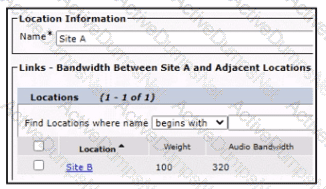
Refer to the exhibit. An engineer deploys CAC to Cisco UCM. UptofiveG.711 calls must be supported on the WAN link between Site A and Site B. Users report that only four concurrent calls are possible between Site A and Site B. Why isn't the filth concurrent call successful?
An administrator configured Cisco Unified Mobility to block access to remote destinations for certain caller IDs. A user reports that a blocked caller was able to reach a remote destination. Which action resolves the issue?
An administrator is implementing a new dial-plan on Cisco Unified Border Element. The administrator must ensure that incoming dial-peers are matched based on the IP address from where the incoming request originates. Which dial-peer configuration should be applied to accomplish this requirement?
Refer to the exhibit.
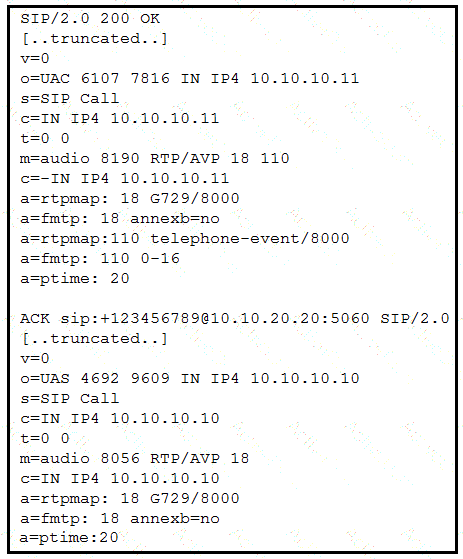
Users report that when they dial to Cisco Unity Connection from an external network, they cannot enter any digits. Assuming only in-band DTMF is supported, what is a reason for this malfunction?
Refer to the exhibit.
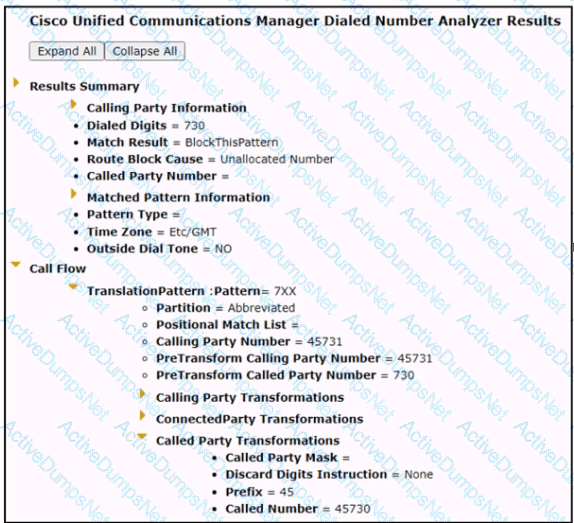
A user cannot call number 730. which Is an abbreviated number for 45730. The engineer recently configured a translation pattern In Cisco UCM. The newly configured translation pattern of 7XX prefixes the digits 45. The engineer uses DNA to troubleshoot the issue. What is the reason for this problem?
Refer to the exhibit.

A no-way audio situation was experienced after the calling party on an outbound call placed the call on hold and then resumed from hold. Which action will resolve the issue?
A user’s phone is already configured for Single Number Reach, and the user wants a feature to move an active call from a mobile phone to a desk phone and vice-versa. As an administrator, which additional configuration should be made to fulfill the user’s request?
An engineer is configuring call queuing to place callers in a queue until hunt members are available to answer them. The engineer also must set the option to automatically log off an agent that does not answer a queuing-enabled hunt pilot call.
Which Cisco UCM menu is used to accomplish this goal?
When you troubleshoot H.323 call setup, which message informs you that the called party is being notified about the call?
Calls are not working when sent from a Cisco Unified Border Element to a service provider. After investigating the logs, the engineer notes that the Cisco Unified Border Element is sending the extension only. How is the issue addressed in the configuration?
Cisco SIP IP telephony is implemented on two floors of your company. Afterward, users report intermittent voice issues in calls established between floors. All calls are established, and sometimes they work well, but sometimes there is one-way audio or no audio. You determine that there is a firewall between the floors, and the administrator reports that it is allowing SIP signaling and UDP ports from 20000 to 22000 bidirectionally. What are two possible solutions? (Choose two.)
A user reports that when they attempt to log out from the Cisco Extension Mobility service by pressing the Services button, they cannot log out. What is the most likely cause of this issue?
Some Cisco mobility users cannot resume calls on the desk phone after they hang up on a mobile phone. The users have Cisco IP phones registered to the Cisco UCM. Which set of configuration steps resolve the issue?
A company has users that frequently visit locations outside the office. These users need to be able to make calls and keep the company integrity by presenting a company caller ID. The users are equipped with company-paid mobile phones. The company uses Cisco UCM with Cisco Unified Border Element and Expressway-C and Expressway-E for external communications. Which technology must be configured to meet this requirement?
A customer is using a SIP trunk to route calls to ITSP to decrease the possibility of downtime, the customer invested in a failover device How does the customer ensure reachability to ITSP, so that if one device on ITSP fails, the calls will be routed to another device?
An engineer configured extension mobility to allow users to roam between phones while taking their numbers and specific device settings with them. Users are now getting "Error:- XML Error [4| Parse Error" on their phones. Which action will resolve this issue?
An administrator discovers that employees are making unauthorized long-distance and international calls from logged-off Extension Mobility phones when the authorized users are away from their desks Which two configurations should the administrator configure in the Cisco UCM to avoid this issue? (Choose two.)
A collaboration engineer is configuring call pickup for a Cisco UCM user that currently has a working BLF speed dial button for the teammate's extension. The user wants to see calls ringing on the teammate's extension and to answer those calls by pressing the BLF speed dial button. Which configuration step meets this requirement?
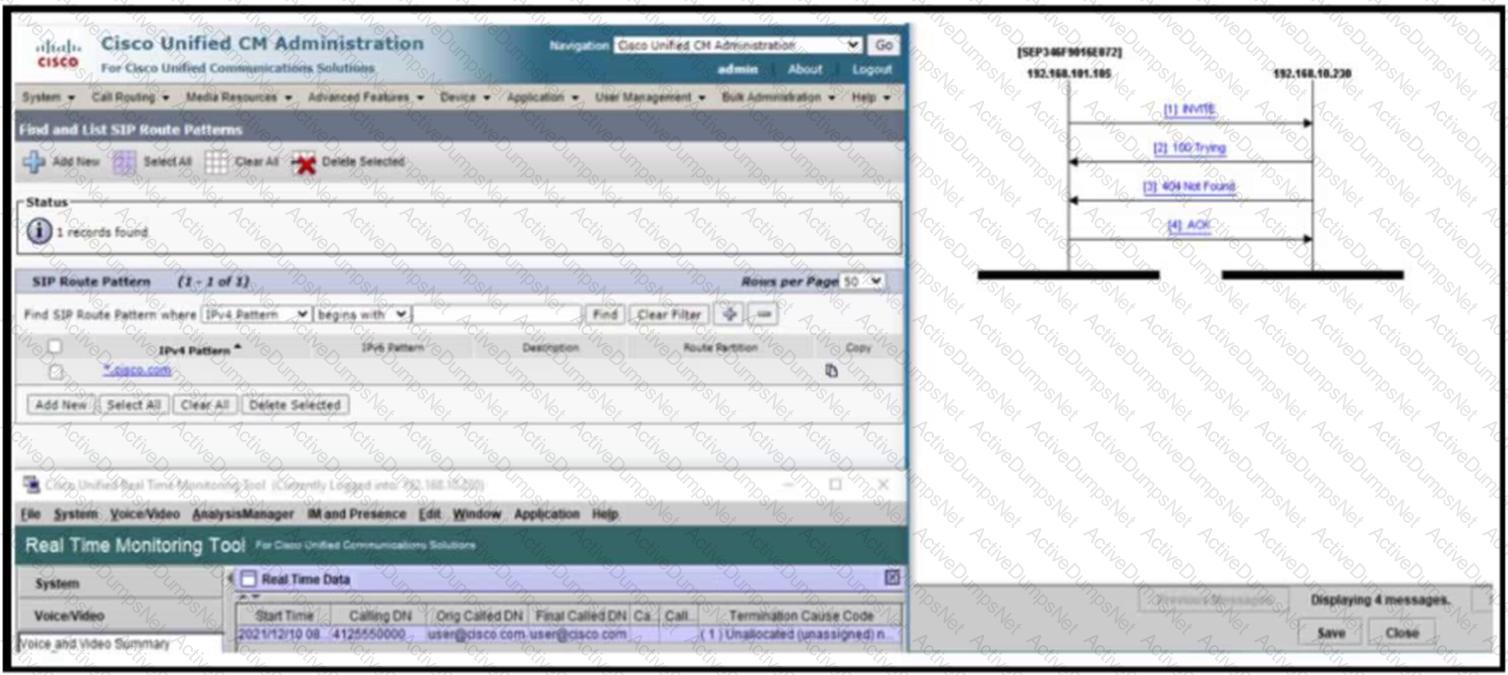
Refer to the exhibit. A collaboration engineer is troubleshooting a Cisco UCM issue where users report that calls placed to the domain cisco.com are failing and calls to sip.cisco.com are working. Which action resolves the issue?
In Cisco Unified Communications Manager globalized call routing is implemented and must confirm that it is correctly implemented without making a call. Which tool do you use for verification?
What is first preference condition matched in a SIP-enabled incoming dial peer?
A company is experiencing an issue where calls from the Cisco UCM via Cisco Unified Border Element to the ITSP fail with a “500 server internal error” right after a 183 session in progress is sent back from the ITSP. What must be enabled to resolve the issue?
An administrator is configuring a SIP trunk to an ITSP. The SIP connection will traverse from a Cisco UCM to the ISTP through a Cisco Unified Border Element. The ITSP has indicated that they require an in-band method for DTMF. Which command on the outbound dial-peer to the ITSP will meet this requirement?
The Cisco Unified Communications Manager Dialed Number Analyzer allows analysis of calls from which two devices? (Choose two.)
An administrator is configuring Meet-me conferencing in a Cisco UCM deployment and has created the Meet-me number and ensured that it is in a partition accessible by all devices. Which two additional steps must the administrator perform? (Choose two.)
Update the softkey template on all phones to ensure that they contain the Meet-me softkey.
An engineer is configuring a Cisco UCM solution. The requirements state that some users in one location will receive calls from a number during work hours 09AM to 5PM, and another group will get the calls from the same number outside this defined timeslot. Users will also change the outgoing number when reaching out to customers based on the same time-of-day routing rules. Which feature is needed to allow for this type of configuration?
Drag and drop the commands from the bottom to the blanks in the code to implement a translation rule to allow only 11 digits to be received over a SIP trunk to a SIP provider. The Cisco UCM is currently sending calls to the Cisco Unified Border Element in E. 164 format. Not all options are used.
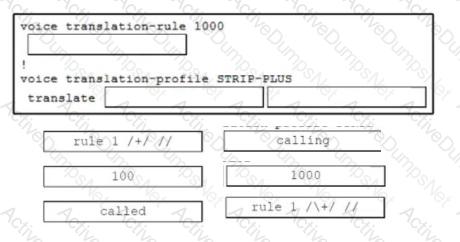
An engineer must configure a Cisco UCM hunt list so that calls to users in a line group are routed to the first idle user and then the next. Which distribution algorithm must be configured to accomplish this task?
A customer reports audio quality issues between video endpoints in the HQ location in California and one of the branches in Texas. Which two actions must RTCP take to troubleshoot this issue? (Choose two.)
An organization has decided to implement hunt groups to help with the distribution of calls between different members. The administrator must configure hunt groups on Cisco UCM. In the configuration, at which step does an administrator have the option to configure a distribution algorithm (top down, circular, longest idle time, broadcast)?
An engineer must configure call queuing under a Hunt Pilot. After the engineer receives the audio file that will be played to callers during queuing, which two steps should be taken to complete the configuration? (Choose two.)
An administrator is attempting to set up redundancy to allow users to make calls even if all Cisco UCM nodes go down or are unreachable by the IP phones.
Which feature must the administrator configure to accomplish this goal?

Refer to the exhibit. A collaboration engineer is troubleshooting an issue where a user of a Cisco UCM IP phone reports failed calls when trying to dial out to the PSTN. Which action resolves the issue?
An administrator is troubleshooting call failures on an H.323 gateway via the CLI. To see signaling for media and call setup, which debug must the Administrator turn on?
The sales department must answer phones when other sales members are not at their desks. The administrator knows that configuring Call Pickup allows the sales users to answer all the calls in the department by pressing only the softkey. Which call pickup configuration meets this requirement?
A company is using Cisco Jabber on-premises to make B2B calls on video. The calls are using Cisco Expressway-C and Expressway-E and have been configured in Cisco UCM to be able to call any URI on the internet. The Jabber client also has voice enabled and must be able to call local, regional, and international numbers. Where must Cisco UCM be configured to meet this requirement for URI dialing?
A company has users that are logged in to hunt groups. However, there is a requirement for hunt group configurations to provide an option to turn on audible ringtones when calls to a line group arrive at a phone that is logged out and on a break. This ringtone alerts a logged-out user that there is an incoming call to a hunt list to which the line is a member, but the call does not ring at the phone of that line group member because of the logged-out status. Which action meets this requirement?
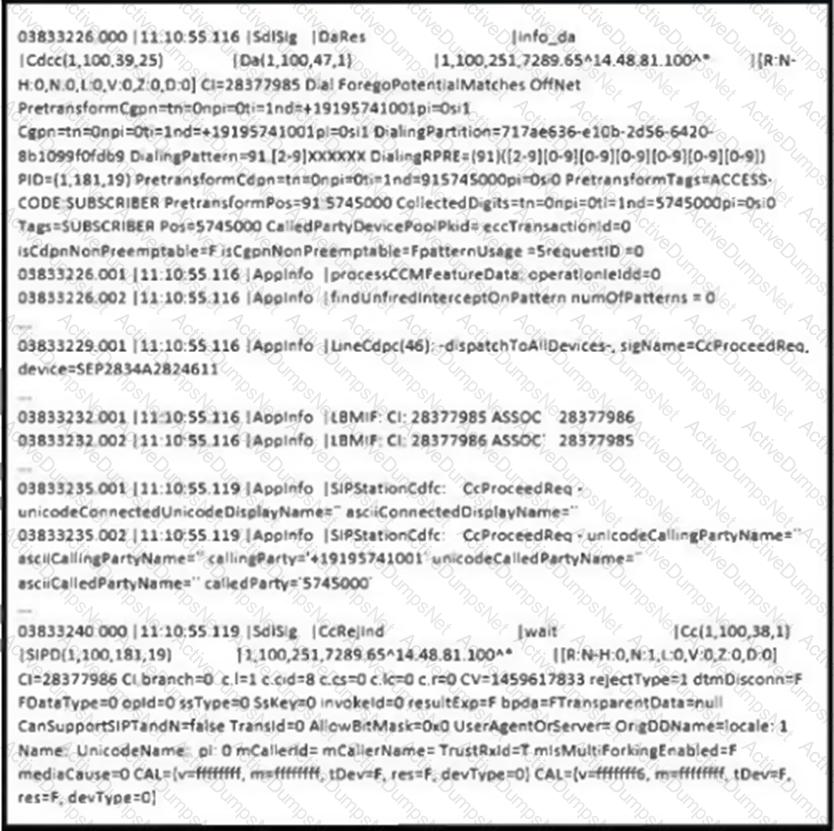
Refer to the exhibit. An administrator configured a new SIP trunk between Cisco UCM and Cisco Unified Border Element. Calls that use this new trunk are failing, and debugs from the Cisco Unified Border Element do not show any signaling received from Cisco UCM. The administrator verified that OPTIONS is enabled on the SIP profile configured on the trunk on Cisco UCM. The route pattern matched for this call is correctly configured to send calls to the Cisco Unified Border Element using this new trunk. What is the cause of this failure?
An engineer is configuring Cisco UCM lo forward parked calls back to the user who parked the call if it is not retrieved after a specified time interval. Which action must be taken to accomplish this task?
An engineer must route all SIP calls in the form of
An engineer needs to deploy the local route group feature to a Cisco UCM server by using the standard local route group. For each device pool, the engineer needs to specify a different PSTN access for emergency calls. What must the engineer do?
An organization configures a SIP trunk in Cisco UCM to connect to another system. These requirements must be met:
1. Use a specific IP address for SIP signaling.
2. Encrypt the signaling traffic.
3. Restrict which devices can use the SIP trunk. 4 Simplify SIP signaling.
Drag and drop the Cisco UCM configuration steps from the left onto the order on the right to achieve these goals.

An administrator configured Extension Mobility on Cisco UCM. Users report that logins are successful, but the phones do not have an Extension Mobility option after logging in. The administrator verified that Extension Mobility is enabled on the devices and that the log-out profile is valid. Which action must the administrator take to resolve the issue?
An engineer needs to deploy Cisco Extension Mobility. The engineer already activated the required services, configured the Extension Mobility Phone Service, and created an Extension Mobility device profile that is associated with end users. Which two additional steps are required to complete the configuration? (Choose two.)
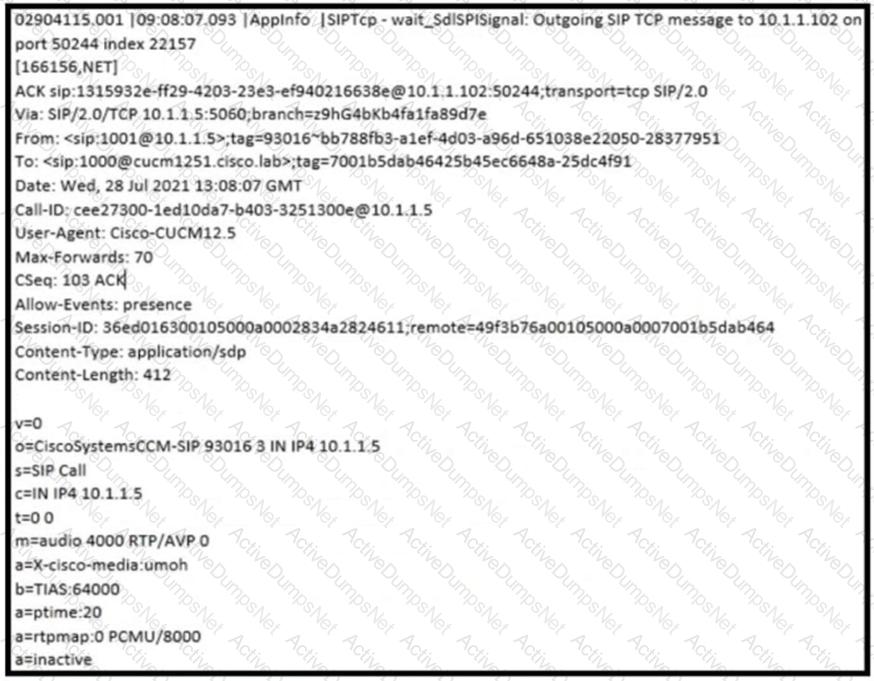
Refer to the exhibit. This message is sent to the device being placed on hold for the Music On Hold audio setup. The held party reports receiving dead air rather than music when the call was put on hold. The software Music On Hold server on Cisco UCM is used in this scenario. Assume that the audio leg between the Music On Hold server and the held device uses G.711, and the relevant region relationship is configured for 64 kbps. What is the cause of the issue?
Which IOS command creates a SIP-enabled dial peer?
An administrator is troubleshooting call failures on an H.323 gateway via the CLI. To see signaling for media and call setup, which two debugs must the administrator turn on? (Choose two).
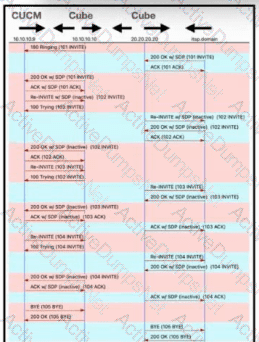
Refer to the exhibit. During a troubleshooting session, an engineer was presented with this call flow output diagram after a user reported issues with a call via the SIP ITSP to a counterpart. What is occurring with this call flow?
Users in a small location report that audio calls work Tine, but only one video call works before the next one gets a busy signal. Three video conference rooms were recently installed by a third party. The audio and video devices are Cisco endpoints. The site uses video and audio calls, and a network investigation does not show saturation on the link The site is configured with QoS and CoS. All devices are registered on the headquarters Cisco UCM duster. What is the cause of this problem?
CollabCorp is a global company with two clusters, emea.collab corp and apac.collab.corp. URI dialing is implemented and working in each cluster. The company configured routing between clusters to make inter-cluster calls via URI. but this is not working as expected. Which two configuration elements should be checked to resolve this issue? (Choose two.)
Alter a new SIP trunk is configured from a third-party SIP trunk provider, the call does not seem to work. A troubles hooting tool and a trace log from the Cisco Unified Border Element shows that there is communication with the provider and that it is sending out SDP information in the 2XX response. Why is the call not working?
Which set of commands binds SIP media and signaling to interface GigabitEthernet0/0 when dial peer 1 is chosen for call routing?
Which description of RTP timestamps or sequence numbers is true?
Refer to the exhibit.

Which change to the translation rule is needed to strip only the leading 9 from the digit string 9123548?
Exhibit.
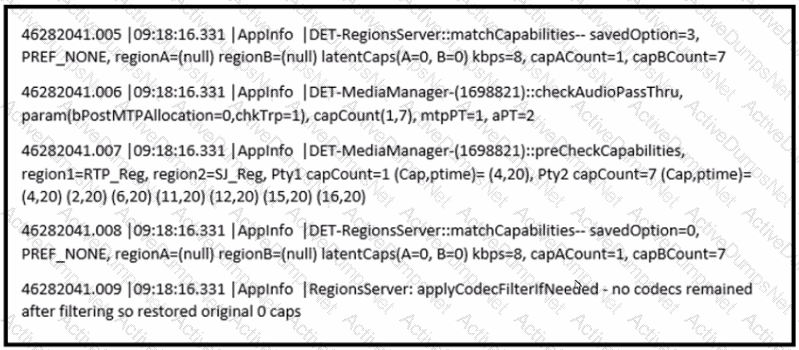
Refer to the exhibit. All calls from site A to site B are failing, and the issue has been identified as a media negotiation problem. Which configuration change resolves the issue?
Users are reporting that several inter-site calls are failing, and the message "not enough bandwidth" is showing on the display. Voice traffic between locations goes through corporate WAN. and Call Admission Control is enabled to limit the number of calls between sites. How is the issue solved without increasing bandwidth utilization on the WAN links?
Some users report having issues dialing some external numbers when traveling to other locations within the company. The company has five locations in five cities in one country and has an egress gateway in each location for TEHO. The configuration has no specific entry stating that the roaming users are using the local gateway, but calls are going out. How is a verification of the call routing in such a specific configuration performed to further identify the problem?
Refer to the exhibit.

Users report high delays when calling national numbers in the United States. An engineer analyzes the route patterns in Cisco UCM. What must be done to resolve this issue?
An SRST site must use pickup functionality on the Chicago remote site to allow the users to take incoming calls. The pickup command is configured under the call-manager-fallback section on the SRST router What are two results of that configuration? (Choose two.)
Which two types of distribution algorithm are within a line group? (Choose two.)
An administrator is troubleshooting call failures on an H.323 gateway via the CLI. To see signaling for media and call setup, which debug must the Administrator turn on?
When configuring hunt groups, where do you add the individual directory numbers that will be part of the group?
An engineer needs to configure a translation pattern in Cisco UCM to match dialed numbers that start with 9011 so that the calls can be routed with a single route pattern of VH If the engineer uses translation pattern 9011.! which two called party transformation settings must be configured in Cisco UCM? (Choose two.)
When configuring hunt groups, where does the administrator add the individual directory numbers that should be part of the group?
A user reports when they press the services key they do not receive a user ID and password prompt to assign the phone extension. Which action resolves the issue?


